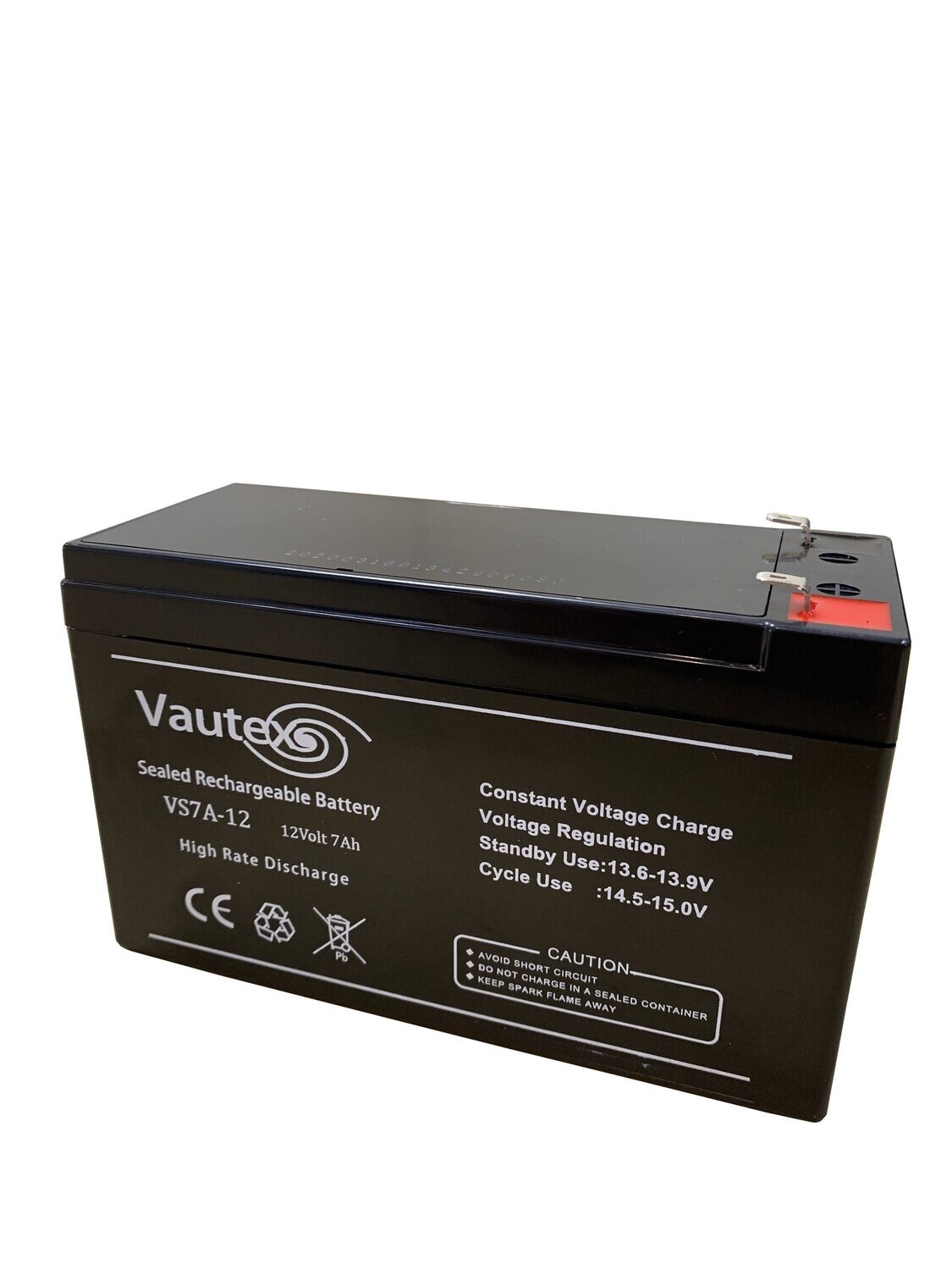
Battery Vautex Calcium Lead Acid 12V 7A/hr
Vautex 7Ah 12V Calcium Lead Acid Battery VS7A-12
General Features
INTRODUCTION
The sealed lead-acid battery consists of a special lead- calcium alloy plates and high capability absorptive clapboards. The battery is valve-regulated, sealed and maintenance fee. All batteries carry a 1-year manufacturer’s warranty against defect manufacturing defect.
***No Return on batteries***
What’s in the Box
- 1 x Battery
Dimensions:
65 X 151 X 105 (W-D-H)mm 2Kg
C20 Capacity: 7 A/h’s
Lug Terminal
Battery Weight: 2 kg’s
Dimensions (mm): 151 (L) x 105 (W) x 65 (H)
Estimated 600 cycles @ 50% depth of discharge at 25 deg. C
(^) The most common battery rating is the AMP-HOUR RATING. This is a unit of measurement for battery capacity, obtained by multiplying a current flow in amperes by the time in hours of discharge. (Example: A battery which delivers 5 amperes for 20 hours delivers 5 amperes times 20 hours, or 100 ampere-hours.)
In order to get an AH rating, the battery that is being tested has to be drained down to 0 over the course of a specified amount of time. The amount of amperage that it took to get it down to zero, over that specified amount of time constitutes the AH rating. Because of the Peukert effect (Google this), the faster a battery is drained, the less overall amperage is available. If you discharge a battery over the course of 100 hours, the AH rating looks higher that if you discharge that same battery over the course of 1 hour. So, there has to be a standard.
For deep cycle batteries the standard rating is 20 hours. So, if a battery has a rating of 100AH @ 20 Hr rate, then that battery was discharged over 20 hours with a 5 amp load. Starting batteries on the other hand, are typically rated at 10Hr rate, because they are used faster, so the 20Hr rate is not as important.
# Reserve capacity minutes (RCM), also referred to as reserve capacity (RC), is a battery's ability to sustain a minimum stated electrical load; it is defined as the time (in minutes) that a lead-acid battery at 80 °F (27 °C) will continuously deliver 25 amperes before its voltage drops below 10.5 volts.
*Battery Council International (BCI) Trade organization of lead-acid battery manufacturers Cranking Amperes (CA), also sometimes referred to as marine cranking amperes (MCA), is the amount of current a battery can provide at 32 °F (0 °C).
Recommended charging ampere: 0.1C; Therefore 0.1 x 7A/h (VS7A) = 0.7Amps charging
FEATURES
- Calcium maintenance free dual purpose battery
- Wrought lead-calcium grids
- Low-Resistance envelope separators
- High strength polypropylene case
- Heat Sealed covers
- Dual terminals
Cycles vs Lifespan
A battery "cycle" is one complete discharge and recharge cycle. It is usually considered to be discharging from 100% to 20%, and then back to 100%.
However, there are often ratings for other depth of discharge cycles, the most common ones are 10%, 20%, and 50%. You have to be careful when looking at ratings that list how many cycles a battery is rated for unless it also states how far down it is being discharged.For example, one of the widely advertised telephone type (float service) batteries have been advertised as having a 20-year life. If you look at the fine print, it has that rating only at 5% DOD - it is much less when used in an application where they are cycled deeper on a regular basis. Those same batteries are rated at less than 5 years if cycled to 50%. For example, most golf cart batteries are rated for about 550 cycles to 50% discharge - which equates to about 2 years.
(See Product Images for Typical Discharge / Recharge Cycle vs. Depth of Discharge (DOD) Curve for Conventional Deep Cycle Marine Batteries)
Battery life is directly related to how deep the battery is cycled each time. If a battery is discharged to 50% every day, it will last about twice as long as if it is cycled to 80% DOD. If cycled only 10% DOD, it will last about 5 times as long as one cycled to 50%. Obviously, there are some practical limitations on this - you don't usually want to have a 5 ton pile of batteries in your bilge sitting there just to reduce the DOD. The most practical number to use is 50% DOD on a regular basis. This does NOT mean you cannot go to 80% once in a while. It's just that when designing a system when you have some idea of the loads, you should figure on an average DOD of around 50% for the best storage vs cost factor. Also, there is an upper limit - a battery that is continually cycled 5% or less will usually not last as long as one cycled down 10%. This happens because at very shallow cycles, the Lead Dioxide tends to build up in clumps on the the positive plates rather in an even film.
